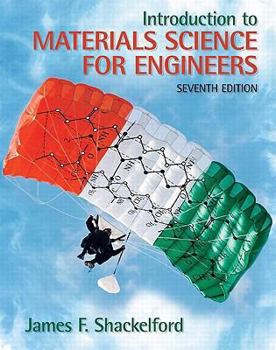Introduction to Materials Science for Engineers
Select Format
Select Condition 
Book Overview
This book is intended for use in a first course in Materials Sciences and Engineering taught in the departments of materials science, mechanical, civil and general engineering. It is also a suitable... This description may be from another edition of this product.
Format:Hardcover
Language:English
ISBN:0136012604
ISBN13:9780136012603
Release Date:January 2008
Publisher:Prentice Hall
Length:533 Pages
Weight:2.50 lbs.
Dimensions:0.9" x 8.0" x 10.1"
Customer Reviews
5 ratings
Chapter 3
Published by Thriftbooks.com User , 20 years ago
Chapter 3, being the 2nd longest chapter, is full of plenty of valuable information. It is by no means a recreational reading material due to the wordy nature of the text. However, studied closely there is a bountiful amount of information on metal, ceramics and plastics at the atomic level. The author does a good job explaining the introductory material and could possible write another book entirely on this subject. Due to the wordy, technical nature, I will refrain from giving "two thumbs up" and only give 4 stars.
Chapter 15
Published by Thriftbooks.com User , 20 years ago
Chapter 15 of "Materials Science for Engineers" describes the physical properties of electrical behavior. This chapter does a good job of explaining the properties of conduction and resistance. It also explains why metals are good conductors and what actually happens in a semiconductor material. This textbook is good as a prerequisite text before starting the core studies in electrical engineering. It provides a good background to the phenomena of electrical behavior at the atomic level.This chapter, as well as the other chapters involving electricity, deal with material properties and not the physics of electricity.This chapter hints at the property of superconductivity. I still don't fully comprehend this topic after reading chapter 15, but there are numerous publications written about this concept alone.
A decent book, Ch6 for example
Published by Thriftbooks.com User , 20 years ago
Chapter 6 covers the topic of Mechanical Behavior in 6 sub-sections. These sections include the stress versus strain relationship (a.k.a. Young's Modulus), elastic and plastic deformation, hardness, creep and stress relaxation, and viscoelastic deformation. Section one discusses Young's Modulus in relation to metals, ceramics and glasses, and polymers. In this sub-section, engineering stress/strain and the differences between elastic/plastic deformations are discussed, as well as yield strength and tensile strength. This section includes some nice reference tables, and describes the stress/strain curve in great detail.Sections two and three discuss elastic and plastic deformations. In the latter section, the slip plane for crystalline solids is well covered with some interesting illustrations.Section four discusses hardness tests, in particular, Rockwell hardness and Brinell hardness numbers.Creep and stress relaxation are discussed in section five, and covers the dislocation climb in plastic deformation among other topics. I feel that a better explanation regarding the preexponential constant is needed in this section.The last section deals with viscoelastic deformation, and discusses various topics such as the glass transition temperature, viscous deformation, and softening temperatures. Also of interest is the subject of tempered glass, which is discussed in some detail.This chapter does well in describing the general terminology and includes several equations with a practical application through example problems. In my opinion, though, this chapter doesn't cover enough information to answer some of the end of chapter problems, but a little on-line research should yield the required information.
Chapter 2 Review
Published by Thriftbooks.com User , 20 years ago
Chapter 2 does a good job of describing the fundamentals of atomic bonding. The chapter starts out by reviewing the basic structure of the atom being the nucleus and the electrons. The nucleus is the center of the atom that is made up of protons and neutrons while the electrons are contained in the surrounding "shells" or orbitals. Throughout the beginning they explain the differences between the two types of bonding that can occur between atoms, the preliminary and the secondary bonding. They include the ionic, covalent, metallic, and the Van der Waals bonds. There are a few ideas that are mentioned for a reminder such as the mass of the proton and neutron, electron and Avagadro's number, which represents the number of protons necessary to provide a mass of 1 gram. There is an explanation of the orbital system and hybridization and a brief description of the different bonds mentioned in the preliminary and secondary bonding. Not only does the author describe the basics of the bond it does a good job of determining the origin of the bond, such as the ionic bond being the result of the Coulombic attraction. As a result of the easily understood explanations, they do supply brief definitions of the bond length, repulsive force, bonding force and bonding energy. Another topic that is touched on is the idea of the coordination number (CN) which depends on the ion properties. Following the CN, a definition of the different properties of the bonds and electrons and bond angles is thoroughly explained. Another thorough explanation is provided for the "Van der Waals" bonding, which is the attraction of opposite charges while there is no actual electron exchange. There are two types being permanent and temporary. I would recommend this book for a thorough explanation of the atomic structure.
GOOD
Published by Thriftbooks.com User , 21 years ago
This book is not as bad as the previous reviewer described. I think its useful





